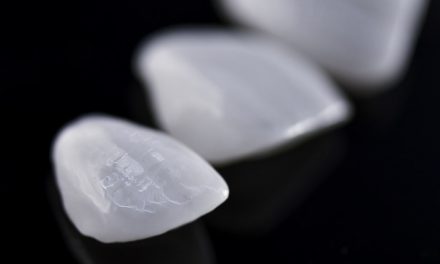GLASS CERAMIC TEETH
Dental prostheses are held to a very high standard. Not only should they look natural, but they should also be able to withstand accidental biting on something hard, like a prune pit for instance. Ideally the patient should be able to wait in the dentist’s chair while the dental prosthesis is milled and then inserted. If a tooth is damaged and needs to be repaired, dentists make use of various materials, which includes glass ceramic teeth.
This not only achieves a very natural look for the prosthesis, but the dentist is also able to finish the glass ceramic prosthesis in his practice. Before starting on the prosthesis, the dentist records the exact location of the teeth in the patient’s mouth with the aid of a pencil camera.
After computer software has processed the CAD data, a milling machine then cuts the crown automatically and with great precision via CAM. This is followed by the time-consuming process of curing and hardening the blank at a minimum temperature of at least 800°C. As the colour of the dental crown may change during this heating process, it is possible that it may not match the colour of the patient’s teeth. However, this can be easily modified by the use of a veneer.
Glass ceramics were thought to have achieved their maximum potential with further improvements not considered likely. Both dentists and patients wanted a product that could be rapidly and individually tailored while the patient waited in the dentist’s chair – what is known as ‘chairside treatment’. What was also needed was a dental prosthesis that was strong enough to withstand the significant wear and tear of being in a patient’s mouth for a long time.
Now, some creative thinking has led to exactly such a dental prosthesis being developed. In conjunction with the companies VITA Zahnfabrik H. Rauter GmbH & Co. KG and DeguDent GmbH, Dr Bernhard Durschang and Dr Jörn Probst of the Fraunhofer Institute for Silicate Research ISC in Würzburg have achieved this award-winning breakthrough.
Dr Probst has been the head of the health application area at the Fraunhofer ISC since 2002. He points out that at more than 500 MPa, their glass ceramic is significantly stronger and more durable than conventional glass ceramics, which peak at about 350 MPa. Post-curing in a furnace is also no longer required.
The glass ceramics not only have the translucency of enamel, but are also available in a wide variety of pleasing colour tones. This ensures that the prosthesis can be perfectly matched to the patient’s own tooth colour, thus ensuring a completely natural look.
But how did the researchers manage to make so many improvements to a material that was thought to have reached its optimal potential? Glass ceramics contain both a crystalline and an amorphous glass phase. Traditionally, researchers focused on improving the crystalline phase as that was the phase that gave the material its strength.
However, the two Fraunhofer scientists set this conventional wisdom aside and concentrated on the properties of the glassy phase – with amazing results. Dr Bernhard Durschang has been engaged in glass ceramic research at Fraunhofer since 1996. He explains that it was the addition of metal oxides to the amorphous glass portion of the ceramics that improved its strength and the overall strength of the material.
Currently this project has expanded far beyond just the development of the actual glass ceramics. With a CE-certified production plant, the two partner companies have benefited greatly from this initial research, and these new glass ceramic teeth are already being widely used by numerous dentists. The annual revenue generated by this product for the two partner companies already stands in the double digit million range, with annual growth rates of about 20% anticipated for the future.




